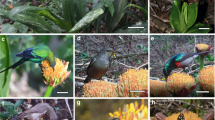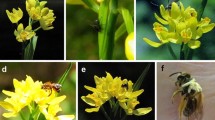Abstract
Reproductive success of plants may be affected by interactions with co-flowering species either negatively, through competition for pollinators, or positively, by means of a magnet species effect and floral mimicry. In this study, potential interactions between Iris tuberosa, a rewarding species, and Ophrys fusca, a sexually deceptive orchid, were explored in four populations in southern Italy. In each population plots showing different ratios of the examined species were arranged in the field, and in each plot the number of pollinators and fruit set were assessed. In addition, flower size and floral hydrocarbons produced by the two species were analysed. Morphological and scent data pointed out that flower size and aliphatic compounds did not differ significantly between the two species. Interestingly, both species shared tricosane and 11-nonacosene, electrophysiologically active compounds in the shared dominant pollinator Adrena. We have found that fruit production and number of pollinators in I. tuberosa varied significantly among plots, while percentage of capsules and number of pollinators of O. fusca captured showed no significant differences across plots. These results suggested, that the presence of O. fusca contributes differentially to pollinator attraction, and thus, to total reproductive success of I. tuberosa, according to a different ratio of aggregation. These findings suggest that I. tuberosa profits from the greater abundance of insects attracted by the presence of orchid specimens, and that a sexually deceptive orchid may be a magnet species in pollination strategy.







Similar content being viewed by others
References
Arcangeli G (1895) Sull’ Hermodactylus tuberosus. Boll Soc Bot Ital 6:182–184
Ayasse M, Schiestl FP, Paulus HF, Ibarra F, Francke W (2003) Pollinator attraction in a sexually deceptive orchid by means of unconventional chemicals. Proc R Soc B 270:517–522
Bellusci F, Pellegrino G, Palermo AM, Musacchio A (2010) Crossing barriers between the unrewarding Mediterranean orchids Serapias vomeracea and S. cordigera. Plant Species Biol 25:68–76
Bohman B, Phillips RD, Menz MHM, Berntsson BW, Flematti GR, Barrow RA, Dixon KW, Peakall R (2014) Discovery of pyrazines as pollinator sex pheromones and orchid semiochemicals: implications for the evolution of sexual deception. New Phytol 203:939–952
Cortis P, Vereecken NJ, Schiestl FP, Barone Lumanga MR, Scrugli A, Cozzolino S (2009) Pollinator convergence and the nature of species’ boundaries in sympatric Sardinian Ophrys (Orchidaceae). Ann Bot 104:497–506
Dafni A (1984) Deception, mimicry and parasitism in pollination. Ann Rev Ecol Syst 15:159–278
Dafni A, Ivri Y (1981) Floral mimicry between Orchis israelitica Baumann and Dafni (Orchidaceae) and Bellevalia felexuosa Boiss (Liliaceae). Oecologia 49:229–232
Delforge P (2005) Guide des orchidées d’Europe, d’Afrique du Nord et du Proche-Orient. Delachaux & Niestlé, Paris
Dodson CH, Frymire GP (1961) Natural pollination of orchids. Mo Bot Gard Bull 49:133–152
Ellis AG, Johnson SD (2010) Floral mimicry enhances pollen export: the evolution of pollination by sexual deceit outside of the Orchidaceae. Am Nat 176:143–151
Evans LJ, Raine NE (2014) Changes in learning and foraging behaviour within developing bumble bee (Bombus terrestris) colonies. PLoS One 9:e90556
Gaskett AC (2010) Orchid pollination by sexual deception: pollinator perspectives. Biol Rev 86:33–75
Geber MA, Moeller DA (2006) Pollinator responses to plant communities and implications for reproductive character evolution. In: Hardes LD, Barrett SCH (eds) The ecology and evolution of flowers. Oxford University Press, Oxford, pp 102–119
Gigord LDB, Macnair MR, Stritesky M, Smithson A (2002) The potential for floral mimicry in rewardless orchids: an experimental study. Proc R Soc B 269:1389–1395
Goldblatt P, Manning J (2006) Radiation of pollination systems in the Iridaceae of sub-saharan Africa. Ann Bot 97:317–344
Gumbert A, Kunze J (2001) Color similarity to rewarding model plants affects pollination in a food deceptive orchid, Orchis boryi. Biol J Linn Soc 72:419–433
Imbert E, Wang H, Conchou L, Vincent H, Talavera M, Schatz B (2014) Positive effect of the yellow morph on female reproductive success in the flower colour polymorphic Iris lutescens (Iridaceae), a deceptive species. J Evolut Biol 27:1965–1974
Internicola AI, Page PA, Bernasconi G, Gigord LDB (2007) Competition for pollinator visitation between deceptive and rewarding artificial inflorescences: an experimental test of the effects of floral color similarity and spatial mingling. Funct Ecol 21:864–872
Jersáková J, Johnson SD, Kindlmann P (2006) Mechanisms and evolution of deceptive pollination in orchids. Biol Rev 81:219–235
Johnson SD (2000) Batesian mimicry in the non-rewarding orchid Disa pulchra, and its consequences for pollinator behavior. Biol J Linn Soc 71:119–132
Johnson SD, Peter CI, Nilsson A, Ågren J (2003) Pollination success in a deceptive orchid is enhanced by co-occurring rewarding magnet plants. Ecology 84:2919–2927
Kullenberg B, Bergström G (1976) The pollination of Ophrys orchids. Bot Not 129:11–19
Mathew B (1987) The smaller bulbs. Batsford BT, London
Moeller DA, Geber MA (2005) Ecological context of the evolution of self-pollination in Clarkia xantiana: population size, plant communities, and reproductive assurance. Evolution 59:786–799
Nilsson AL (1983) Mimesis of bellflower (Campanula) by the red helleborine orchid Cephalanthera rubra. Nature 305:799–800
Pellegrino G (2014) Pollinator limitation on reproductive success in Iris tuberosa L. (Iridaceae). AoB Plants. doi:10.1093/aobpla/plu089
Pellegrino G, Musacchio A, Noce ME, Palermo AM, Widmer A (2005) Reproductive versus floral isolation among morphologically similar Serapias L. species (Orchidaceae). Jour Hered 96:15–23
Pellegrino G, Bellusci F, Musacchio A (2008) Double floral mimicry and the magnet species effect in dimorphic co-flowering species, the deceptive orchid Dactylorhiza sambucina and rewarding Viola aethnensis. Preslia 80:411–422
Peter CI, Johnson SD (2008) Mimics and magnets: the importance of color and ecological facilitation in floral deception. Ecology 89:1583–1595
Phillips RD, Peakall R, Hutchinson MF, Linde CC, Xu T, Dixon KW, Hopper SD (2014) Specialized ecological interactions and plant species rarity: the role of pollinators and mycorrhizal fungi across multiple spatial scales. Biol Conserv 169:285–295
Pignatti S (1982) Flora d’Italia. Edagricole Bologna, Italy
Renner SS (2006) Rewardless flowers in the angiosperms and the role of insect cognition in their evolution. In: Waser NM, Ollerton J (eds) Plant–pollinator interactions: from specialization to generalization. University of Chicago Press, Chicago, pp 123–144
Sapir Y, Shmida A, Fragman O, Comes HP (2002) Morphological variation of the Onocyclus irises (Iris: iridaceae) in the southern Levant. Bot J Linn Soc 139:369–382
Schiestl FP (2005) On the success of a swindle: pollination by deception in orchids. Naturwissenschaften 92:255–264
Schiestl FP, Ayasse M, Paulus HF, Löfstedt C, Hansson BS, Ibarra F, Francke W (1999) Orchid pollination by sexual swindle. Nature 399:421–422
Schiestl FP, Peakall R, Mant J, Ibarra F, Schulz C, Francke S, Francke W (2003) The chemistry of sexual deception in an orchid–wasp pollination system. Science 302:437–438
Schiestl FP, Peakall R, Mant J (2004) Chemical communication in the sexually deceptive orchid genus Cryptostylis. Bot J Linn Soc 144:199–205
Schmid-Egger C, Scheuchl E (1997) Illustrierte Bestimmungstabellen der Wildbienen Deutschlands und Österreichs, Band III, Andrenidae. Eigenverlag, Velden
Scopece G, Musacchio A, Widmer A, Cozzolino S (2007) Pattern of reproductive isolation in Mediterranean deceptive orchids. Evolution 61:2623–2642
Spaethe J, Streinzer M, Paulus HF (2010) Why sexually deceptive orchids have colored flowers. Commun Integr Biol 3:139–141
Steiner KE (1998) The evolution of beetle pollination in a South African orchid. Am J Bot 85:1180–1193
Stökl J, Paulus H, Dafni A, Schulz C, Francke W, Ayasse M (2005) Pollinator attracting odour signals in sexually deceptive orchids of the Ophrys fusca group. Plant Syst Evol 254:105–120
Stökl J, Schlüter PM, Stuessy TF, Hannes F, Paulus GA, Ayasse M (2008) Scent variation and hybridization cause the displacement of a sexually deceptive orchid species. Am J Bot 95:472–481
Thompson JD (1978) Effect of stand composition on insect visitation in two-species mixtures of Hieracium. Am Midl Nat 100:431–440
Tremblay R, Ackerman JD, Zimmerman JK, Calvo RN (2005) Variation in sexual reproduction in orchids and its evolutionary consequences: a spasmodic journey to diversification. Biol J Linn Soc 84:1–54
van der Cingel NA (1995) An atlas of orchid pollination. Balkema AA, Rotterdam
Velleman PF (2012) DataDesk: an interactive package for data exploration, display, model building, and data analysis. WIREs Comput Stat 4:407–414
Vereecken NJ, Wilson CA, Hötling S, Schulz S, Banketov SA, Mardulyn P (2012) Pre-adaptations and the evolution of pollination by sexual deception: cope’s rule of specialization revisited. Proc R Soc B 279:4786–4794
Whitehead MR, Peakall R (2014) Pollinator specificity drives strong prepollination reproductive isolation in sympatric sexually deceptive orchids. Evolution 68:1561–1575
Author information
Authors and Affiliations
Corresponding author
Rights and permissions
About this article
Cite this article
Pellegrino, G., Bellusci, F. & Palermo, A.M. Who helps whom? Pollination strategy of Iris tuberosa and its relationship with a sexually deceptive orchid. J Plant Res 129, 1051–1059 (2016). https://doi.org/10.1007/s10265-016-0853-9
Received:
Accepted:
Published:
Issue Date:
DOI: https://doi.org/10.1007/s10265-016-0853-9




